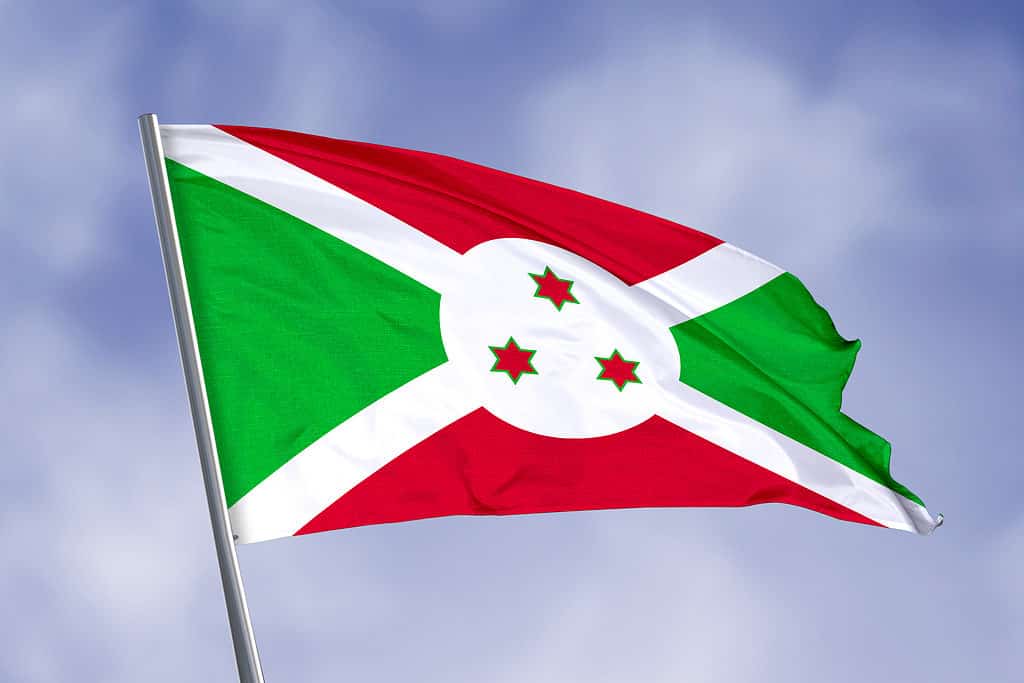The flag of Burundi is a vibrant and symbolic representation of the East African nation’s history, culture, and values. Burundi’s flag is steeped in patriotism and pride, with a trio of colors that represent the country’s past, present, and future. This article explains the history, meaning, and symbolism behind this iconic flag. Keep reading to learn all about the flag of Burundi!
Where is Burundi?

Burundi is a small country in Africa home to sprawling national parks and wetlands.
©Tudoran Andrei/Shutterstock.com
Burundi is a small landlocked country in east-central Africa. Rwanda borders the country to the north, Tanzania to the east and south, and the Democratic Republic of the Congo to the west. This lush tropical paradise is home to sprawling national parks and wetlands, with Lake Tanganyika its largest body of water. Although Burundi is small, it is surprisingly diverse with stunning natural scenery. From rolling hills to wild rainforests and savannas, Burundi offers an array of breathtaking landscapes for visitors and locals alike.
Burundi’s culture is a colorful tapestry influenced by tradition, local customs, and other East African societies. Art forms such as masks, statues, baskets, and pottery are common, with drumming being particularly popular. The Royal Drummers of Burundi are one of the nation’s most famed cultural groups. With its vibrant culture and rich heritage, this African nation truly has something special to offer.
History and Origin of Burundi’s Flag
The flag of Burundi has undergone numerous changes throughout the years. In the late 19th century and early 20th century, the country was occupied by German colonists, who flew the East African Company flag as a symbol of power. After the Great War (World War I), Belgium took control of Burundi and replaced their nation’s previous flag with one featuring their own colors. However, this oppression soon came to an end when in 1961 Burundi finally achieved independence and adopted a new banner for themselves.
This new flag rose on July 1, 1962, when Burundi’s independence became official. It was used until 1966 when the monarchy was abolished. The flag featured a karyenda drum propped up majestically on top of a sorghum plant. The art of drumming is an important aspect of Burundi’s culture and history. The ancient karyenda drum is an iconic symbol representing royalty in Burundi. Only the mwami or ruler could translate the drum’s beatings into rules to govern the kingdom.
The Meaning and Symbolism of the Flag of Burundi

Burundi’s flag is both beautiful and symbolic, with a stark white diagonal cross dividing two bright green triangles from two vivid red ones.
©Tatohra/Shutterstock.com
The current flag of Burundi, adopted in 1967 after the country’s independence from Belgium, stands as a visual representation of the nation’s strength and history. Its bold design is both beautiful and symbolic, with a stark white diagonal cross dividing two bright green triangles from two vivid red ones. While its visual appeal may be the first thing you notice, the colors of the flag are particularly meaningful for the country.
The three-colored flag of Burundi is a reminder of the nation’s tumultuous yet inspiring history. The red triangles represent the struggle and bloodshed during Burundi’s struggle for independence. The green triangles represent hope for the future and progress. The white diagonal cross and the white central circle on the flag symbolize peace.
At the center of the Burundi flag is a white circle and three prominent six-sided red stars with green outlines. These stars symbolize the country’s national motto of “Unity, Work, Progress”, an allusion to the importance and beauty of coming together despite differences. Moreover, these stars also pay tribute to their three main ethnic groups — the Hutu, Tutsi, and Twa peoples — who have called Burundi home for at least 500 years. Last but not least, the three stars also represent Burundi’s historic loyalty to God, king, and country.
The National Coat of Arms of the Republic of Burundi
The Republic of Burundi’s national coat of arms is another powerful representation of the country’s rich history and culture. This emblem features three African spears crossed behind a red and yellow shield. The shield features a large lion’s head in the middle (the Transvaal lion (Panthera leo melanochaita) is one of Burundi’s national animals). Beneath the shield is Burundi’s national motto, written in French on a white banner: “Unité, Travail, Progrès” (“Unity, Work, Progress”).
Up Next:
- Animals in Burundi
- The 15 Largest Lakes in Africa
- The Flag of the Democratic Republic of Congo: History, Meaning, and Symbolism
- Discover the Longest Lake in the World: Lake Tanganyika
The photo featured at the top of this post is © Wasan Ritthawon/Shutterstock.com
FAQs (Frequently Asked Questions)
What do the colors of Burundi's flag represent?
The flag of Burundi uses three colors: red, green, and white. Red represents the country’s struggles and sacrifices made for freedom and independence. Green represents hope for future progress. White represents peace.
What do the symbols of Burundi's flag represent?
At the center of the flag of Burundi are three red stars with green outlines. These three stars have several meanings. First, they symbolize the original ethnic groups of Burundi (the Hutu, Tutsi, and Twa peoples). They also represent Burundi’s national motto, “Unity, Work, Progress.” In addition, the three stars allude to the country’s historical loyalties to God, king, and country.
Thank you for reading! Have some feedback for us? Contact the AZ Animals editorial team.






